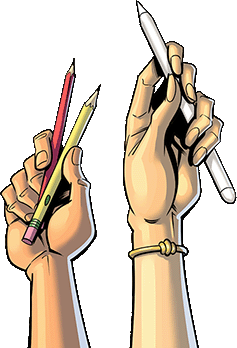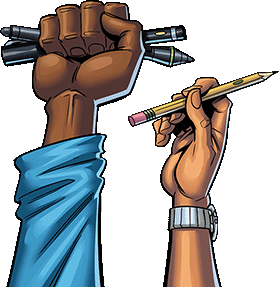How to Write a Graphic Novel
June 3, 2021
Graphic novels have begun to break into the mainstream, especially since icons like Frank Miller have made movies based on comic books more popular than ever. Daredevil (2003) and Batman: The Dark Knight Returns (2013) are just two examples of box office hits based on Miller’s graphic novels. Standalone stories sometimes draw critical acclaim for their powerful use of sequential art as a storytelling tool, and long-running franchises can remain in the hearts and minds of fans for decades.
If you've considered creating your own graphic novel, there's no better time than now to get started. Technology like cloud storage and drawing tablets make it easier than ever for artists and writers to collaborate digitally from anywhere in the world.
However, creating a graphic novel will always be a time-consuming process, and you will have to keep your eye on your goal to stay motivated. Here's what to know as you prepare to start your journey to make your own comic book or graphic novel.
What is a Graphic Novel?
A graphic novel is any story that uses a large number of illustrations or pictures to convey key elements of the story. A few pages are mostly text, but even these are usually accentuated with small drawings or color elements. Graphic novels are different from regular novels with illustrations because graphic novels rely on art to tell the story.
The Characteristics of a Graphic Novel
Graphic novels use multiple panels per page to tell the story in sequence. These panels will often be squares or rectangles, but artists can use other shapes or do a panelless splash page as well. In most of the world, graphic novels are read from left to right and top to bottom like regular books, but Japanese manga and graphic novels are usually read the opposite way even after they are translated.
How Is It Different From a Comic Book?
Typically, graphic novels are longer than comic books. A comic book will be 32-64 pages, while a graphic novel is usually 100 pages or more. Graphic novels are typically published as volumes, while comic books are first published as single issues.
In addition, graphic novels are usually printed with perfect binding, also known as square binding. This type of binding is stronger than the traditional stapled or saddle-stitched binding used on comic books. Plus, the square binding makes it possible to print a title on the spine.
A Brief History of the Graphic Novel
Comic strip art and political cartoons have hundreds of years of history, but the modern graphic novel did not emerge until after the basic comic book. They primarily developed in the past century after superhero comics gained their popularity. They branched out into different genres over time, including educational and non-fiction works for various people.
How Do You Make a Graphic Novel and Why Do They Take Such a Long Time to Make?
Graphic novels intertwine art and a good story, so the creation process requires various stages of both. Modern graphic novels are usually created digitally, which allows for easier revisions, but it's still challenging to go back and make significant story changes once art is even partially complete. With this in mind, graphic novels always start with thorough scripting.
The combination of writing and art required makes the graphic novel creation process take longer than a novel with a story of comparable length. However, you can always team up with an artist or additional writer to create your own graphic novel faster.
Decide What Kind of Story You’re Telling
The best way to write a graphic novel is to write the types of stories you like to read. This means deciding on a genre like science fiction or detective noir and thinking about the overall themes and target audience. This is an excellent time to start brainstorming the main characters, but keep an open mind and be willing to adjust based on other ideas you get from your research.
Start With a Story Idea and Some Research
Once you have your genre and overall themes in mind, the first thing to do is start new ideas for the actual plot. You should know the basic point of the story before you start putting any lines to paper in your script.
The amount of research you have to do will vary depending on the genre. For example, if you are writing a basic school life story about high school students, you might not need to do much research at all. However, you will want to do extensive research on settings for historical fiction and technology for science fiction stories. Just reading a few articles about the basics of your setting won't work.
Write Your Outline and Script
Diving into writing every single word and detail of the story, starting with the first scene, will only increase the time you spend on revisions later. Instead, outline your script first, with just the basics of each scene and key lines in each. After that, you can start writing each line of your script, with notes on settings and action as needed.

Find an Artist or Improve Your Skills
If you want to draw the art yourself, make sure you have a solid grasp of the fundamentals of anatomy, perspective, and best practices for keeping your files clean and ready to print at the end. Since these skills take years to hone, it may be more worthwhile to hire or collaborate with an artist online. Art school graduates who have taken many of the fundamental courses may be good partners for your project.
Tighten Your Pacing and Dialogue
Make sure your story is as streamlined as possible, cutting extra words and lines without removing any necessary characterization or drama. You can revise the script before finding an artist, but artists sometimes have good ideas for eliminating unnecessary parts of the story. This is especially true if they have previous experience in drawing graphic novels, but even rookies can help with the revision process.
Draw the Storyboards
Like with the previous step, initial storyboarding can occur earlier in the drafting process. You can go back and remove lines and scenes depending on how the storyboards end up looking, then redraw the storyboards for your final draft. The best thing about storyboards is that they allow you to more solidly establish each scene and make sure character locations and actions are consistent between panels and pages.
Decide on Size and Format
Before starting the final art, take one last opportunity to confirm your size and format to make sure you create high-resolution files with the proper templates. Although there is a standard graphic novel size, some use a smaller manga size for printing, and some use a magazine size for printing. You will also need an estimate of the number of graphic novel pages so you can decide whether it is a single-volume or longer story.
Make the Comic Book or Graphic Novel
Completing the actual pages is the most time-consuming part. If you put enough work into the writing and planning steps, however, you should be able to keep revisions to a minimum and avoid the headache of redrawing art or rearranging panels.
The author and the artist should thoroughly sketch out all pages before starting lineart or colors. This way, you can ensure all your planned images and text will fit into the confines of your page layout. You can sketch pages by hand and ink them digitally, do everything traditionally with ink pens, or do everything digitally.
Tips to Sell and Promote Your Comic Book
You can start promoting your work before it's even finished. However, keep in mind that most readers won't get too excited until they see at least one finished volume from you. Once you have an established fan base, you may be able to drum up interest in future works more quickly.
Use social media to drive up hype, making sure to show plenty of visuals to catch readers' attention. Also, stock up on freebies like bookmarks to promote preorders or thank fans in-person at conventions.
Ready to Make Your Own Comic Book?
Remember that you don't have to be a professional illustrator or working in animation to create an action-packed comic. The important thing is to love graphic novels and be willing to hone your technique as you create a finished product that's the best it can be. From there, you can share the final book with your original story with your friends.
Comix Well Spring is the go-to source for everyone, from indie comic veterans to teachers trying to print quick learning materials for their students. We can help you self-publish your own comic strips, graphic novels, and more as you find your own story. Contact us at (734) 345-6852 with any questions about our services.
FAQs
How do I turn my book into a graphic novel?
You should start by simplifying your book into a script and potentially cutting or modifying scenes that don't flow quickly in graphic novel format. After that, proceed with the same general storyboarding and art steps.
How long does it take to make a graphic novel?
Creating a graphic novel usually takes several months unless it is a full-time endeavor with multiple staff. For most indie creators writing and drawing outside of their full-time job, a graphic novel of 200 pages will take at least a year.
How many pages is a graphic novel?
Graphic novels typically range from around 100 to 250 pages. Longer works will usually be broken into multiple volumes.


